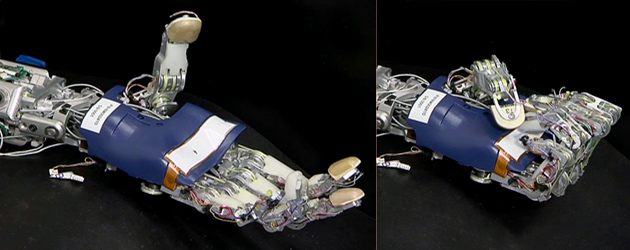
Strong but lightweight materials and advances in technology have translated into more comfort and higher function for amputees.
In the past artificial limbs were made of wood and existed without moving joints, so that above the joint amputations in particular severely limited the mobility of the individual. In addition, the heavy wooden construction made the use of a prosthesis difficult and uncomfortable. Now, modern lightweight materials increase the comfort level of prosthetic use enormously, and new technology allows much more freedom of movement, even with above the joint amputations.
Prosthetic devices with moveable joints have gone through a number of transformations.
Developing from a fairly clumsy mechanical joint to ones with robotic capability, joints have gone from operating using the musculature of the affected limb to being able to directly access electrical impulses from the body of the amputee, or from a computer within the artificial limb itself. In addition, robotic devices using built-in computer technology allow for much more subtle limb movements, allowing for more natural capability.
This new technology has translated into an immense sense of freedom for the amputee. People wearing these modern limbs are running marathons, participating in downhill ski competitions, and engaging in all sorts of sports and other recreational activities that were barred to them in the past. Perhaps even more importantly, they are more easily able to function in the everyday world, meeting work requirements along with their non-disabled coworkers, and keeping up with family and friends in their free time.
An Increase in Self-Esteem
When a previously able-bodied person is suddenly faced with amputation of one or more limbs, whether because of an accident, war injury, complications of diabetes, or cancer, the trauma of the situation is a blow to the individual's core identity. One's body image is shattered, and a host of fears set in: fear of losing mobility, becoming dependent on others for their basic care, of facing a lifetime of severely limited opportunities.
Being fitted with a modern, functional artificial limb and then learning to use it can seem like a kind of miracle. As people become more proficient and realize the possibilities opening up to them, their self-esteem soars, and they can begin to look forward to a productive, happy and option-filled life.
The Future of Prosthetics
The technology continues to improve in this important area of medicine. Currently, scientific researchers are perfecting a computerized robotic limb which can be directed by neuronal impulses in the brain - in other words by an individual's thoughts. As the science of prosthetics progresses, it promises to further enhance the lives of those maimed by amputation.